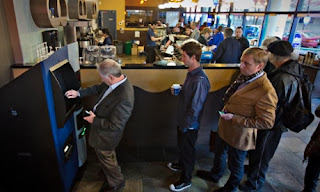The Christmas "Holiday" is over and time to pay the bills. A little bit here and a little bit there..It’s amazing how it grows! We shop with credit cards, debit cards, checks and even “on-line”. Some people even use cash! There are several ways to pay the bills. Times are changing.
When the English colonists arrived in America, they naturally continued to use the pound, shilling and pence which they used back in England . Later, these colonists had to use wampum and even tobacco as mediums of exchange. Spanish “visitors” used the Spanish silver dollar to pay for their needs.Massachusetts began
 |
| Indian waumpam |
-----------------
European countries are attempting to unify their monetary standard with the “Euro”. Most European countries have joined the European Union and the Euro is the common currency. Norway is not a member state of the European Union and won’t use the Euro. Norway has been under the control of several countries in it’s history and since gaining their own identity, Norway likes independence! Norway continues to use the krone, or in plural, kroner with bank notes of 50, to 1000 kr. At this time, a krone is worth about sixteen cents U.S.
--------------
While serving as a 1950’s GI in the Army and stationed in Germany, I was paid monthly in paper “scrip” or  |
| Ten-dollar US scrip money |
 |
| French coin currency |
--------------
Time to standardize? Today’s method is to direct deposit and use plastic cards or one of the latest electronic smart-phones, I-pods or even the computer. Things are changing ..a bit! With all the new uses of our electronic gadgets, money can now be stored in your computer.. as bits!! Somehow, I have never seen a “bit”. Apparently, it has been around since 2009. What is a “bit" besides being a portion of time?
If "Bits" were really coins..
Something called a bitcoin is the newest “currency” established in 2009.
It’s an electronic means of monetary exchange, only done using computers. It’s a “cryptographic monetary exchange” using computer zeros and 111s code! They call it “bitcoin!” controlled by passwords and electronic signature guarantees sent and stored on everyone’s computer. It's becoming quite a thing!
--------------
 A Norwegian, Kristoffer Koch invested 150 kroner ($26.60) in 5,000 bitcoins in 2009 He forgot about them until media coverage of the anonymous peer-to-peer digital currency in April 2013 jogged his memory. The value of a bitcoin had wildly gone up within the space of four years. He discovered that his $27 investment when “cashed in” was then worth $886,000.00. What an investment return!
A Norwegian, Kristoffer Koch invested 150 kroner ($26.60) in 5,000 bitcoins in 2009 He forgot about them until media coverage of the anonymous peer-to-peer digital currency in April 2013 jogged his memory. The value of a bitcoin had wildly gone up within the space of four years. He discovered that his $27 investment when “cashed in” was then worth $886,000.00. What an investment return!
------------
However, this new method of electronic exchange has acquired a poor reputation due to actions such as that of a group known as a black-market ring entitled “The Silk-Road”, a drug-ring that requires all illicit drug buyers and sellers to use bitcoins in their transactions due to the difficulty of tracing the monetary exchange. 
Bitcoins can be stored in your computer as encrypted wallets secured with a private key ( a password). In April, 2013, the value of a bitcoin was $266 before crashing to $50.00 due to rapid flucations such as the seizure of online drug marketpace transactions such as “The Silk Road” that caught government attention.
--------------
Bitcoin has been endorsed by a Wall Street currency analyst who has claimed it shows “clear potential for growth”, but national banks are cynical. The Bank of France has released a report calling the currency “highly speculative” and saying it poses a “certain financial risk” for owners.
-------------
For bitcoin users, there is GLIP, an “app” that provides the use of back and forth secure texts while utilizing money transfers to friends. Here is a “GLIP” in action....
--------------
Customers are lining up to use the world’s first-ever permanent bitcoin ATM at a coffeeshop in Vancouver, British Columbia..Times ARE changing!Currently, bitcoins can be used in various businesses.They are quick and free from fees and may be the future of all our transactions. The price of a bitcoin rose above $1,000.00 last month for the first time (a 400 percent surge in less than a month, as of Dec 13..Friday the 13th!!). But again, bitcoin currency is not backed by any central bank or government, or by physical assets. It’s value depends on people’s confidence in the currency.
-------------
If this is for you, Virgin Galactic Aviation has more that 600 “wannabe astronauts” who have already signed up to board the aircraft if all goes well in Richard Branson’s latest venture into space. The price of the flight will be approximately $250,000.00 and bitcoin payments are being accepted to purchase your seat in the next trip into space. Get your bit-coin wallet out and be ready for your historic trip to the moon.
--------------
But first, don't forget those Christmas bills! Hopefully, those "Big-Box stores" will accept bitcoin payments.
Just start saving...A little bit at a time!
















